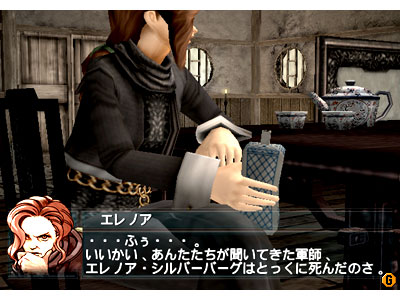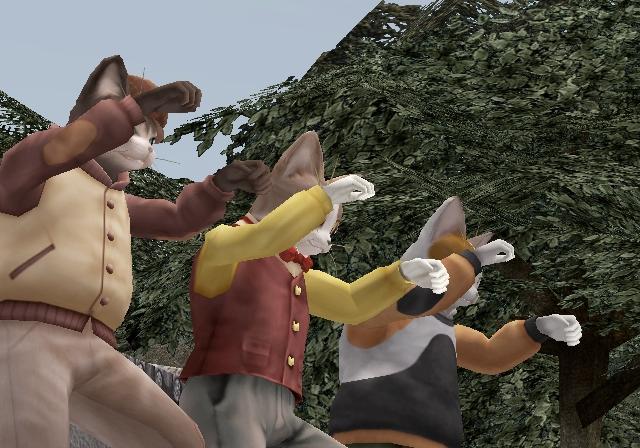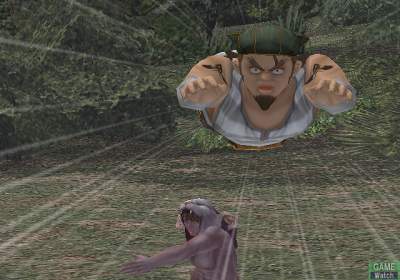|
The Rune of Punishment, one of the 27 True Runes, has traveled across the Island Nations, finding hosts who can use its powerful yet parasitic force, before ultimately turning to them ash, after which it moves to another host, if another is nearby. The Rune ultimately makes its way to the Dukedom of Gaien, where the leader of the Razril Knights, Glen Cott, acquires it and uses its power to obliterate an invading force before turning into ash. One of his knights, seeing the Rune's power, obtains it himself, although his best friend, Snowe Vingerhut, falsely accuses him of killing the commander, and is banished.
Out on the open seas, the former knight of Razril learns that the Kooluk Empire is seeking southern expansion into the Island Nations, and thus, the exiled knight must gather the 108 Stars of Destiny and put a stop to the Empire and its nasty weapon of mass destruction. Many considered Suikoden IV, when it saw its North American release, to be the weakest installment of the franchise, which is in a sense correct, although it is certainly not without redeeming qualities, such as solid combat systems, music, and visuals.
The story has some interesting concepts, although it somewhat falls flat in execution. Snowe Vingerhut, for one, is probably the most detestable videogame character in recent history, yet stands as a superb foil to the strong, silent protagonist. The plot also filches elements from Secret of Mana (a protagonist who obtains a forbidden power and is banished from his hometown), Star Wars (an "evil" empire with a nasty weapon of mass destruction), and even, to slight extent, Final Fantasy V. Overall, the Rune of Punishment is perhaps the only real star of the show, but the plot is by no means bad, just derivative and underdeveloped.
 Legend of the Drunken Strategist
Legend of the Drunken Strategist
|
|
That leaves the gameplay to carry the load, and luckily, Suikoden IV does decently in this area. The first mode of battle encountered is the ship battle, where the player sets up a few ships with crewmembers that can fire rune cannon ammunition at enemy vessels, board an enemy ship to battle its crew, or allow for stat increases such as better ship movement and firing range. Player and enemy ships take individual turns, and when in range, each can fire rune ammunition at one another. Rune ammunition comes in five different elements, and has a Rochambeau formula of effectiveness; for instance, water ammunition will break through fire ammunition and strike the opposing ship, although wind ammunition with break through fire ammunition and strike the opposing ship.
Also featuring a Rochambeau formula of effectiveness are commands in one-on-one duels, where normal attacks, for some reason, beat opponent defense, defense beats opponent special attacks, and special attacks beat normal opponent attacks. As with previous Suikodens, what the player's opponent says will indicate which command they will execute. Overall, both ship battles and duels are somewhat simple, yet are surprisingly enjoyable, with some late-game ship battles such as the last even posing a decent challenge.
Of most heated debate, however, are normal random encounters, with the encounter rate, as many have noted, being somewhat high (although the encounter rates of previous installments weren't exactly consistent, either). Compensating for the encounter rate, however, is that players, if their party's levels are high enough, can simply "Release" weak enemy parties rather than waste time fighting them, since experience gain among characters is proportional to their levels.
 "We want chicken, we want liver, Meow Mix, Meow Mix, please deliver!"
"We want chicken, we want liver, Meow Mix, Meow Mix, please deliver!"
|
|
The actual battle mechanisms are, for the most part, well-executed. Party battles are down to four characters from six in previous installments, although since Suikoden III featured a "buddy system" where the player inputs three commands for six characters, the player actually gets one more battle command this time around. The player can also choose a support character that performs innate functions such as post-battle healing and gaining extra money from battles. After the player inputs various commands for his or her characters, they and the enemy beat each other up, with rounds, and overall combat, usually being fast-paced. All in all, combat in Suikoden IV is by no means perfect, although it is well more than functional.
Perhaps the low point of Suikoden IV's gameplay, however, is the utterly sluggish ship navigation that occurs on the vast open seas separating the Island Nations. The 3-D ship controls don't help matters, since it can be especially difficult to enter towns on islands, given the overly sensitive collision detection that occurs near them, and 2-D ship controls similar to those in the first two Suikoden titles would have been better. Granted, the acquisition of a certain character and her teleportation magic can abet conveyance among visited islands.
Everything else in interaction, however, such as a direction on how to advance the main storyline (with arrows on the map screen in most cases indicating where to go next), generous inventory space, and a super-dash ability acquired after gaining a certain support character, is efficient, and overall, while the game in these particular aspects interfaces well with the player, elements such as sailing and ship controls could have very easily been better.
 I am Superman
I am Superman
|
|
Suikoden IV is by no means an inventive game, with elements such as parts of its story being derivative, and the three modes of combat, other than ship battles, being rehashed from its predecessors. The sailing also brings to mind that in The Legend of Zelda: The Wind Waker, and overall, those looking for an inventive title should perhaps look elsewhere.
One area where Suikoden IV is better than its predecessor, however, is its musical presentation, featuring a nice variety of folk music such as the themes in Razril and the Deserted Island, and even some themes from the first two installments. Much of the cutscene music, moreover, is a definite step above that in Suikoden III. The fourth installment is also first in the franchise to feature voice acting, whose quality, for the most part, is mixed. There are some decent voices, such as Brandeau's, although there are some horrible ones, such as those for the young girls who offer mini-games, like Rita and Noah. This reviewer also noticed that the pronunciation of some area names is inconsistent (for instance, most characters call Razril "Raz-uh-ril"), but full marks do go to the composers for their solid, diverse soundtrack.
Suikoden IV changes visual styles, this time to a more realistic style, with superbly-proportioned character models and decent animation and effects, though the protagonist's dash animation may disturb homophobic gamers. The game also buries itself in Mediterranean hues, with one not expecting to find bright, vibrant, hues colors in isolated archipelagoes and islands. The game does make some compromises to speed up battles, such as simple spell animations and having characters run like the Flash back to their original positions after attacking. The fourth installment, though, allows those with High-Definition TVs to utilize Progressive Scan, which supposedly makes the visuals look better. Overall, the fourth Suikoden is easy on the eyes.
Finally, the fourth installment is shorter than its predecessor, taking somewhere from twenty-five to forty hours to complete, depending upon the sidequests performed, chiefly acquiring all 108 Stars of Destiny, with a replay mode allowing for additional playthroughs. Overall, Suikoden IV does have its flaws, such as an underdeveloped story and flawed world navigation, although these shortcomings actually aren't nearly as game-breaking as many have made them out to be. It could disappoint hardcore fans of the franchise, although those new to the series might find it, given that it's chronologically first in the franchise, to be a decent introduction.
Review Archives
|









